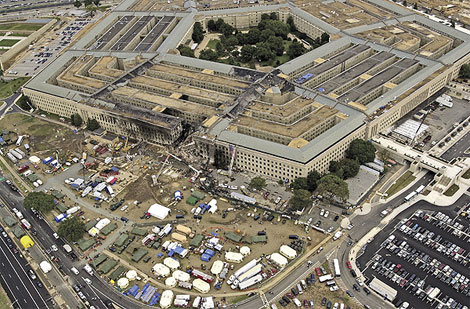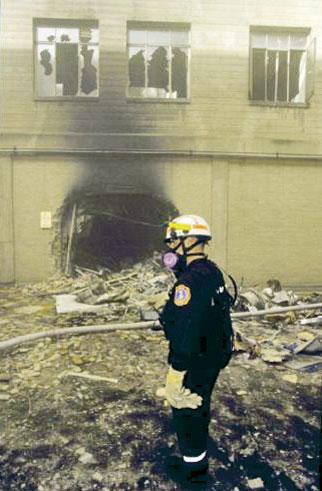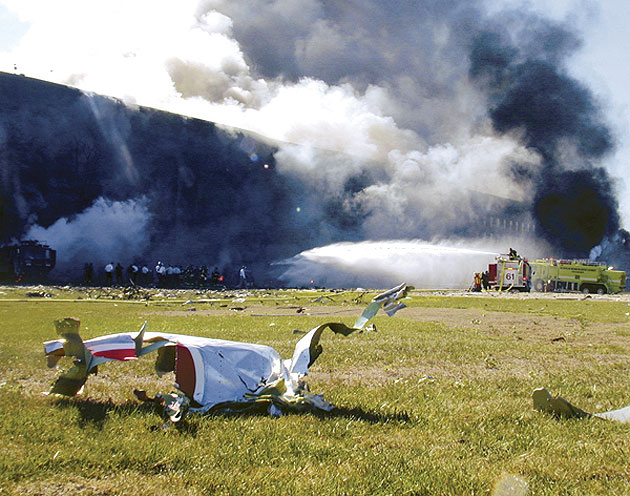The Pentagon
At 9:37 am on 9/11, 51 minutes after the first plane hit the World Trade Center, the Pentagon was similarly attacked. Though dozens of witnesses saw a Boeing 757 hit the building, conspiracy advocates insist there is evidence that a missile or a different type of plane smashed into the Pentagon.

HQ Attack: Taken three days after 9/11, this photo shows the extent of the damage to the Pentagon, consistent with a fiery plane crash. (Photograph by Department of Defense)
Big Plane, Small Holes
Claim: Two holes were visible in the Pentagon immediately after the attack: a 75-ft.-wide entry hole in the building's exterior wall, and a 16-ft.-wide hole in Ring C, the Pentagon's middle ring. Conspiracy theorists claim both holes are far too small to have been made by a Boeing 757. "How does a plane 125 ft. wide and 155 ft. long fit into a hole which is only 16 ft. across?" asks reopen911.org, a Web site "dedicated to discovering the bottom line truth to what really occurred on September 11, 2001."
The truth is of even less importance to French author Thierry Meyssan, whose baseless assertions are fodder for even mainstream European and Middle Eastern media. In his book The Big Lie, Meyssan concludes that the Pentagon was struck by a satellite-guided missile — part of an elaborate U.S. military coup. "This attack," he writes, "could only be committed by United States military personnel against other U.S. military personnel."

Hole Truth: Flight 77's landing gear punched a 12-ft. hole into the Pentagon's Ring C. (Photograph by Department of Defense)
FACT: When American Airlines Flight 77 hit the Pentagon's exterior wall, Ring E, it created a hole approximately 75 ft. wide, according to the ASCE Pentagon Building Performance Report. The exterior facade collapsed about 20 minutes after impact, but ASCE based its measurements of the original hole on the number of first-floor support columns that were destroyed or damaged. Computer simulations confirmed the findings.
Why wasn't the hole as wide as a 757's 124-ft.-10-in. wingspan? A crashing jet doesn't punch a cartoon-like outline of itself into a reinforced concrete building, says ASCE team member Mete Sozen, a professor of structural engineering at Purdue University. In this case, one wing hit the ground; the other was sheared off by the force of the impact with the Pentagon's load-bearing columns, explains Sozen, who specializes in the behavior of concrete buildings. What was left of the plane flowed into the structure in a state closer to a liquid than a solid mass. "If you expected the entire wing to cut into the building," Sozen tells PM, "it didn't happen."
The tidy hole in Ring C was 12 ft. wide — not 16 ft. ASCE concludes it was made by the jet's landing gear, not by the fuselage.
Intact Windows
Claim: Many Pentagon windows remained in one piece — even those just above the point of impact from the Boeing 757 passenger plane. Pentagonstrike.co.uk, an online animation widely circulated in the United States and Europe, claims that photographs showing "intact windows" directly above the crash site prove "a missile" or "a craft much smaller than a 757" struck the Pentagon.
FACT: Some windows near the impact area did indeed survive the crash. But that's what the windows were supposed to do — they're blast-resistant.
"A blast-resistant window must be designed to resist a force significantly higher than a hurricane that's hitting instantaneously," says Ken Hays, executive vice president of Masonry Arts, the Bessemer, Ala., company that designed, manufactured and installed the Pentagon windows. Some were knocked out of the walls by the crash and the outer ring's later collapse. "They were not designed to receive wracking seismic force," Hays notes. "They were designed to take in inward pressure from a blast event, which apparently they did: [Before the collapse] the blinds were still stacked neatly behind the window glass."
Flight 77 Debris
Claim: Conspiracy theorists insist there was no plane wreckage at the Pentagon. "In reality, a Boeing 757 was never found," claims pentagonstrike.co.uk, which asks the question, "What hit the Pentagon on 9/11?"

Aftermath: Wreckage from Flight 77 on the Pentagon's lawn — proof that a passenger plane, not a missile, hit the building. (Photograph by AP/Wide World Photos)
FACT: Blast expert Allyn E. Kilsheimer was the first structural engineer to arrive at the Pentagon after the crash and helped coordinate the emergency response. "It was absolutely a plane, and I'll tell you why," says Kilsheimer, CEO of KCE Structural Engineers PC, Washington, D.C. "I saw the marks of the plane wing on the face of the building. I picked up parts of the plane with the airline markings on them. I held in my hand the tail section of the plane, and I found the black box." Kilsheimer's eyewitness account is backed up by photos of plane wreckage inside and outside the building. Kilsheimer adds: "I held parts of uniforms from crew members in my hands, including body parts. Okay?"



